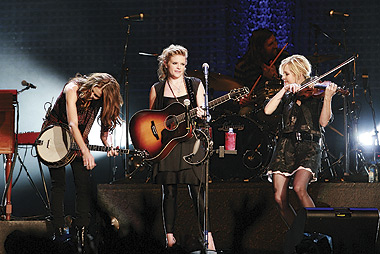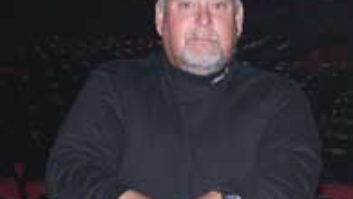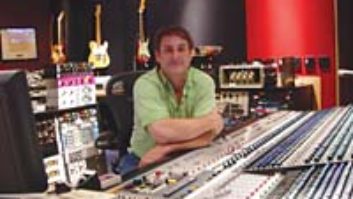
All photos: Steve Jennings
Fern Alvarez, who has been handling the Dixie Chicks’ front-of-house mixing responsibilities for just about a decade, has seen numerous changes while touring with this three-piece. Most notably, each tour has grown in size — from band and crew traveling across the U.S. in a single bus to this year’s world tour, which has been playing to packed arenas in support of the Chicks’ latest album, Taking the Long Way.
But not much seems to rattle Alvarez, who is now busy mixing a 12-piece band that, in addition to the Chicks (Natalie Maines, Martie Maguire and Emily Robison), includes three guitar players (David Grissom, Audley Freed and Keith Sewell), drummer Fred Eltringham, bassist Byron House, keyboardist Larry Knechtel, steel guitarist Pete Finney, cellist John Krovosa and violinist Janna Jacoby. For instance, the tour is carrying all of the gear (sans P.A.), creating a level of comfort and recallability for the FOH engineer and two monitor engineers, Marty Strayer and Scott Reikowsky. This truckload of gear includes all of the musicians’ amps and instruments, a trio of Digidesign VENUE consoles (one at FOH and a pair used for monitors), four sidecars and all of the personal monitoring equipment; Alvarez first used the VENUE on a brief run with Lisa Marie Presley in 2005. In addition to the board, The tour has also incorporated two Pro Tools HD rigs — one at FOH and one at monitor position — each capable of recording and playing back for a multitrack archive of each show.
“When we travel, we don’t travel lightly,” Alvarez says with a laugh. “It can be easy to run these consoles with a thumb drive, but we have these rigs set up and routed a special way, and we didn’t want to have to reconfigure someone else’s rig for our comfort. The girls approved it because they want it to be as normal as possible, and when we go overseas, there’s almost no rehearsal time, so there’s no time for prepping.”
In November, the tour stopped at the newly named Oracle Arena in Oakland, Calif., where the band played a rollicking 22-song, 90-plus-minute set that included a variety of their hit songs, including “Goodbye Earl,” “Landslide” and “White Trash.”
Alvarez is using the Clair Bros. i4b line array system — 24 cabinets off left and right with another 16 for side hangs and eight S4 subs — that’s powered by Crown amps and driven by the Clair iO system with a wireless tablet. “I don’t run a lot of dB, just enough to get the information out,” Alvarez explains. “It’s more of an acoustic show with the instruments that the girls play: banjo, acoustic guitar, violin, mandolin, fiddle, dobro. Those types of instruments don’t translate well at a high level of dB.”
The audience members in the front five rows hear the show through 12 Showco L3 cabinets that Alvarez runs off an attenuated left-right matrix. The use of those cabinets negates the need for a central cluster. “The video screen is a priority,” he says with a laugh. “I’ve never done a center cluster because I haven’t really needed one. Natalie gives enough information off her own vocal that you really don’t need it. Vocally, this is the easiest gig to mix because they do such a great job.”
Everyone onstage sings into Shure SM58 microphones with Shure UHF-R systems. Rather than stacking up a pile of outboard gear at the FOH position, Alvarez uses the VENUE’s onboard gates and compressors, as well as a handful of plug-ins. For instance, Maguire and Robison’s vocal tracks are spun through a Bomb Factory BF-2A plug-in, and Maines’ vocal is treated with the McDSP MC2000, Digidesign Smack! and Focusrite d2 EQ plug-ins.

Alvarez also uses plug-ins on some of the band tracks: Line 6 Amp Farm on the bass player’s tracks, a Bomb Factory Slight Rude compressor on the Leslie cabinet and a Purple Audio MC77 limiting amp on the fiddles. There are also a handful of effects, including Digidesign ReVibe and D-Verb, Line 6 Echo Farm and the Eventide H949 Harmonizer. “I have about 25 plug-ins across the console, but I’m up to 78 inputs,” Alvarez says. “I try not to overcompress and overdo things to these inputs. I try to keep it as simple as possible. I use the Purples on the fiddle to warm them up a little. On Natalie’s vocal, I use the McDSP with some Smack to smooth it out a little, and on [Maguire and Robison], I use the BF-2As to warm up their vocals.”
Likewise, miking the band is straight-ahead. All of the guitar cabinets (mostly Black Cat amps) have been isolated and miked with Shure KSM32s. The Leslie cabinet has two Shure Beta 91s on top and a Beta 91 on the bottom. On the drum kit, Alvarez places a Shure KSM137 pencil mic on the ride, hi-hat cymbals and the bottom of the snare drum.
Making sure that 96 channels of RF can be found and used at each venue is one of the challenges that the crew faces each day. However, Alvarez has gotten consistent results with a Lectrosonics Venue Modular system with IM and SM transmitters and no companders — creating a considerably more natural sound.
DUELING MONITOR BOARDS
While Alvarez handles the front-of-house mix, monitor engineers Strayer (who is responsible for personal monitors for Maines, Maguire and Robison), and Scott Reikowsky (who handles the bandmembers’ monitor mixes and their techs) stand together at the side of the stage, each manning a Digidesign VENUE board.

Front-of-house engineer Fern Alvarez uses a Digidesign VENUE console.
Maines uses the Shure PSM700 wireless system, while Maguire and Robison use Sennheiser Evolution Wireless G2 3000 Series. “Natalie uses the Shures because she’s such a powerful singer and she likes the way her voice sounds through it,” Strayer says.
Lately, Maines has been using one ear with a wedge monitor. “She plays an acoustic guitar a lot, so she likes to hear that and the house,” Strayer continues. “She is the most powerful singer I’ve ever dealt with, and she’s got perfect pitch and can go from a whisper to scream.” Her mix is minimal, with bass, kick and snare, along with her voice. The sisters, as the crew calls them, have a bit more of a musical mix. “If you listened to it, it would sound like the CD,” Strayer reports. “It’s pretty even and balanced.”
Strayer has added a sidecar to his VENUE setup. While he punches in some plug-ins, the key is to keep it simple. “Each girl has her own vocal reverb and instrument reverb,” Strayer says. “There’s a drum reverb, but I’m using very little [of it] — I dialed it in once in rehearsals and I haven’t touched it [since]. I use the onboard compression. For some reason, I like them better than the plug-ins, and I think that’s because as a monitor guy, I have to dial it in so fast and I think the plug-in compressors take more time.”
Reikowsky is manning a full console — no spare outputs to be found anywhere. He adds that all of the bandmembers receive stereo mixes except cellist Krovosa and violinist Jacoby, who each get a mono mix. Reikowsky also notes that all members are on Sennheiser Evolution wireless G2 3000 Series personal monitors, while their techs listen through Shure PSM600 wired systems. Reikowsky has also added a Thumper and a pair of Showco B1 subs behind the drummer. “There are no wedges up there, so I put the Thumper and the subs up there for a little ‘oomph,’” he explains.
Similar to the rest of the audio crew, Reikowsky is relying on onboard effects rather than carrying racks of gear, using all of the VENUE’s gates and comps, as well as a handful of plugs. “Nobody wants reverb and nobody asks for it,” he reports. “The musical director said to me, ‘We’re playing parts here. We’re not trying to hide.’ I’m using Amp Farm on the bass because there’s only an Avalon DI behind him. So I put that on to give it a little ‘oomph’ so it sounds like there is some sort of cabinet, and I put some compressors on the subs.”
Reikowsky also runs a unique system where each musician can step on a footswitch that routes the signal to a Mackie mixer instead of the VENUE. This way, the musician can talk directly to him or to the tech. It’s important, Reikowsky says, because, “I can only see the musicians on stage left. I can’t see the musical director or the keyboard player, so it helps me a lot.”
The engineers benefit from a tight band of musicians in full command of their talents, and that enables them to offer the soundtrack without much processing. “We try to tune the vocals as close as possible,” Alvarez says. “That’s what they are all about. If Nat’s vocal is there and it’s a little top-heavy and piercing, that’s what her vocal is all about. I don’t want to color it. I hear it on a nightly basis, but these people pay money to hear what she’s all about and only hear a 90-minute show. I don’t want to overcompensate for my own liking. I do it to make sure everyone else is happy with what they are hearing.”
David John Farinella is a San Francisco-based writer.





